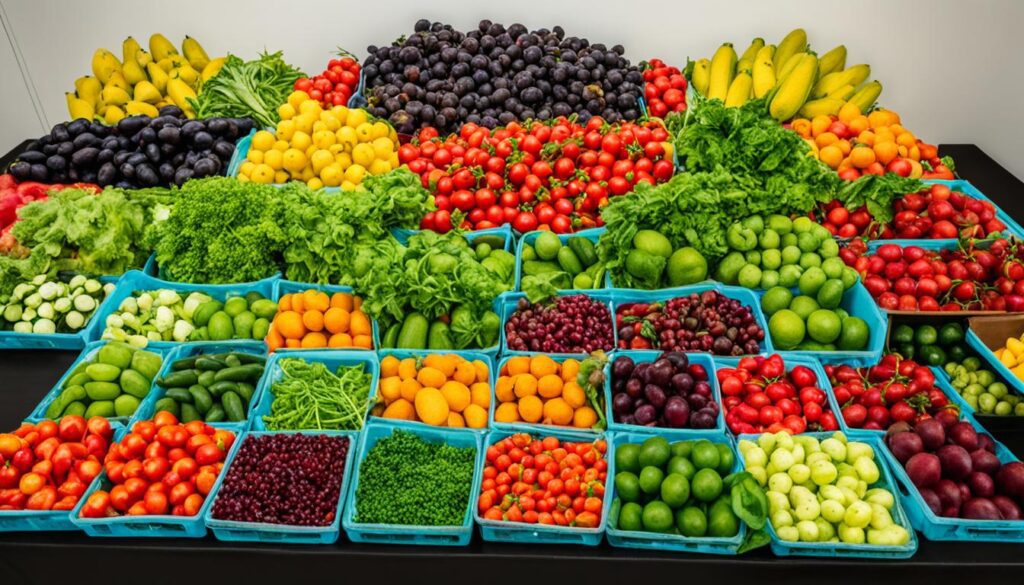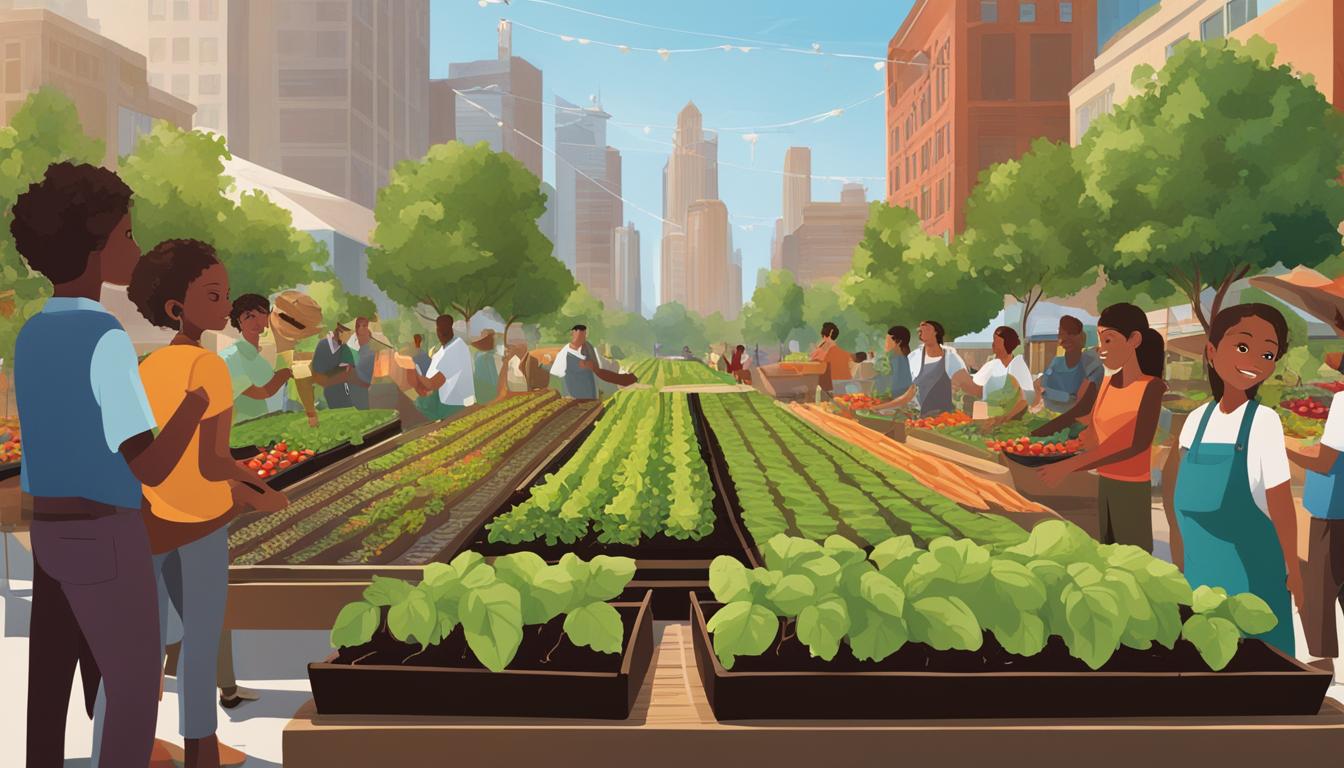Food shortages and their impact on global food security have become increasingly concerning in recent years. With approximately 3 billion people worldwide affected by food insecurity, it is clear that urgent action is needed to address this pressing issue.
As the global population continues to grow, projected to reach 9.3 billion by 2050, the need for sustainable and efficient food production methods becomes even more critical.
In this article, we will explore various solutions to the global food crisis, focusing on sustainable food production and innovative approaches to ensure food security for all. By implementing these strategies, we can create a secure future where everyone has access to nutritious food.
The Growing Challenge of Food Insecurity
Food insecurity is a pressing concern that is expected to worsen in the coming years due to climate change and the growing world population. These factors contribute to the increasing food scarcity and rising food prices, making it difficult for a larger number of people to access nutritious food.
The effects of food insecurity are far-reaching, impacting individuals and communities through malnutrition, micronutrient deficiencies, and obesity. The consequences are especially concerning for vulnerable populations, including children, pregnant women, and the elderly.
To address the challenge of food insecurity, it is crucial to develop sustainable solutions that not only increase food production but also ensure its accessibility and affordability.
The Impact of Climate Change
Climate change exacerbates the problem of food insecurity by altering weather patterns, increasing the frequency and intensity of extreme weather events such as droughts, floods, and storms. These events disrupt agricultural production, leading to crop failures and reduced yields.
Furthermore, climate change affects the availability and quality of natural resources essential for food production, such as water and land. This, coupled with the loss of biodiversity, poses significant challenges to the agricultural sector.
Addressing climate change and implementing sustainable agricultural practices are crucial steps in mitigating the impact of food insecurity. These practices include efficient water management, crop diversification, soil conservation, and the use of renewable energy sources in farming.
Increasing Food Prices
The combination of population growth, changing dietary preferences, and limited agricultural resources has resulted in increasing food prices. As demand outpaces supply, the cost of food rises, making it unaffordable for many individuals and families.
High food prices not only limit access to nutritious food but also contribute to the persistence of hunger and poverty. Moreover, they can create social and political instability, exacerbating existing inequalities and tensions within communities and nations.
To address the issue of increasing food prices, it is crucial to invest in sustainable agricultural practices that improve productivity, reduce post-harvest losses, and enhance supply chain efficiency.
Additionally, supporting local food production, promoting fair trade practices, and implementing social safety nets can help alleviate the burden of rising food costs.
Finding Sustainable Solutions
Addressing food scarcity and ensuring food security requires a multi-faceted approach that considers environmental, social, and economic factors. It involves investing in sustainable agriculture, promoting sustainable consumption patterns, and addressing the root causes of food insecurity.
It is essential to prioritize research and innovation in agricultural technologies, empowering small-scale farmers, and strengthening local food systems. This includes supporting farmers’ access to resources, knowledge, and markets, as well as implementing policies that incentivize sustainable farming practices.
Government initiatives, international collaborations, and community-driven efforts are all necessary to tackle the challenge of food insecurity and build a resilient food system that can sustainably feed the world’s growing population.

Seven Ways to Improve Food Security
Ensuring food security is crucial in addressing global hunger and malnutrition. By implementing effective strategies, we can make significant progress in securing a sustainable food future for all. Here are seven key ways to improve food security:
1. Reducing Food Waste and Loss
Currently, approximately one-third of global food production goes to waste. Reducing food waste and loss is a critical step in improving food security. By implementing measures such as efficient storage, transportation, and distribution systems, we can minimize the amount of food that goes to waste.
This will ensure that more food reaches those in need, reducing the overall scarcity of nutritious food.
2. Improving Infrastructure
A well-developed infrastructure is vital for reducing food loss and improving access to markets. By investing in transportation networks, storage facilities, and cold chain systems, we can prevent post-harvest losses and ensure that food reaches consumers in a timely manner.
Additionally, infrastructure improvements can enhance farmers’ ability to store and preserve their crops, reducing the risk of spoilage and increasing overall food availability.
3. Promoting Fair Trading Practices
Fair trading practices are essential for enhancing food security. By establishing fair and transparent market systems, we can ensure that farmers receive fair prices for their produce.
Fair trade agreements can also protect farmers from exploitation and provide them with economic stability. By promoting fair trading practices, we can create a more equitable food system that benefits both farmers and consumers.
4. Diversifying Crops
Overreliance on a limited number of crops can increase vulnerability to crop failures and contribute to food insecurity. Diversifying crops helps to reduce the risk of complete crop loss and provides a more balanced and nutritious diet for consumers.
Encouraging farmers to grow a variety of crops can also enhance soil health, improve biodiversity, and make agricultural systems more resilient to climate change.
5. Strengthening Local Food Systems
Supporting and strengthening local food systems can play a crucial role in improving food security.
By promoting local agriculture and encouraging the establishment of community gardens and urban farming initiatives, we can increase access to fresh and nutritious food. Local food systems also reduce dependence on imported food, making communities more self-reliant and resilient in times of crisis.
6. Enhancing Farmer Education and Support
Providing farmers with access to education, training, and support services is essential for improving food security. By equipping farmers with knowledge about sustainable farming practices, efficient resource management, and climate adaptation techniques, we can enhance agricultural productivity and resilience.
Additionally, access to credit, insurance, and other support services can empower farmers and improve their ability to invest in their farms.
7. Investing in Research and Development
Continued investment in agricultural research and development is essential for improving food security. By developing innovative technologies, such as drought-resistant crops and precision farming techniques, we can increase agricultural productivity while reducing the environmental impact.
Research and development efforts can also help identify and address emerging challenges in food production, ensuring a sustainable and secure food future.
By implementing these strategies, we can make significant progress in improving food security globally. It is crucial for governments, organizations, and individuals to work together and prioritize sustainable and equitable solutions to combat hunger and malnutrition.

Enhancing Agricultural Practices
Improving agricultural practices is vital in reducing the yield gap and addressing the indirect causes of food insecurity. By adopting efficient techniques such as crop rotation and sustainable production methods, farmers can enhance crop resilience and boost overall productivity.
This not only helps in meeting the increasing food demand but also contributes to reducing food shortages and promoting food security.
Crop rotation is an effective practice where different crops are grown in a sequential pattern over several seasons. This method helps improve soil fertility, control pests and diseases, and minimize weed growth.
By rotating crops, farmers can optimize nutrient utilization and reduce the dependency on chemical fertilizers, resulting in more sustainable agronomic systems.
Image:

Sustainable production methods, such as organic farming and agroforestry, also play a crucial role in enhancing agricultural practices. By minimizing the use of chemicals and incorporating natural pest control methods, organic farming ensures the production of healthier and more nutritious crops.
Agroforestry, on the other hand, involves integrating trees with agricultural crops, which enhances biodiversity, improves soil structure, and provides additional income opportunities for farmers.
In addition to reducing the yield gap, addressing the indirect causes of food insecurity is equally important. Trade imbalances and social insecurity can significantly affect food availability and access, particularly in vulnerable communities.
By promoting fair trading practices and empowering smallholder farmers, we can create a more equitable food system that ensures fair prices for farmers and minimizes market volatility.
Furthermore, combating climate change is paramount in safeguarding agricultural production and preventing crop failures. Extreme weather events, such as droughts and floods, can devastate crops and disrupt food supplies.
Implementing climate-smart agricultural practices, such as efficient water management, conservation agriculture, and the use of drought-tolerant crop varieties, can enhance the resilience of farming systems and mitigate the impact of climate change on food security.
The Four Pillars of Food Security
Food security is essential for the well-being and prosperity of individuals and communities. To ensure a secure future, food security is built upon four pillars: availability, access, utilization, and stability.
Availability:
Availability refers to the production and distribution of food. It involves sustainable farming practices, efficient supply chains, and adequate storage facilities. By promoting sustainable food production methods and reducing post-harvest losses, we can increase the availability of nutritious food for all.
Access:
Access focuses on individuals’ ability to grow and buy food. It includes factors such as economic access, physical access, and knowledge and skills related to food production. By promoting inclusive and equitable food systems, we can ensure that everyone has the resources and opportunities to secure an adequate food supply.
Utilization:
Utilization ensures the safety and quality of food. It encompasses aspects such as proper food preparation, adequate storage, and nutrition education. By promoting good hygiene practices, investing in food safety measures, and providing nutrition education, we can enhance the utilization of available food resources.
Stability:
Stability pertains to the consistency of access to food. It involves the ability to withstand shocks and disturbances, such as natural disasters and economic crises, without compromising food security.
By promoting social safety nets, building resilient food systems, and implementing effective risk management strategies, we can enhance the stability of food access.
Strengthening these pillars is crucial in ensuring food security for all. By addressing the challenges related to availability, access, utilization, and stability, we can build a future where everyone has reliable access to sufficient, nutritious food.
The Role of Technology in Food Security
Technology plays a crucial role in improving food security. It enables agricultural innovations, sustainable food production, and the reduction of food waste. These advancements in technology are essential for addressing the challenges of feeding a growing global population while minimizing the environmental impact of agriculture.
The Power of Agricultural Innovations
Agricultural innovations such as precision farming techniques and genetic engineering have revolutionized the way we grow crops. Precision farming utilizes technologies like drones, GPS, and sensors to optimize inputs such as water, fertilizers, and pesticides, resulting in increased crop productivity and reduced waste.
Genetic engineering allows for the development of crops with improved traits such as disease resistance, higher yields, and enhanced nutritional content. These innovations not only help farmers improve their yields but also contribute to sustainable food production.
Sustainable Food Production Methods
In addition to agricultural innovations, sustainable food production methods play a vital role in achieving food security. Practices such as organic farming and aquaponics prioritize environmental sustainability by minimizing the use of harmful chemicals, conserving water resources, and reducing greenhouse gas emissions.
Organic farming utilizes natural fertilizers, biological pest control, and crop rotation to maintain soil health and biodiversity. On the other hand, aquaponics combines aquaculture (raising fish) and hydroponics (cultivating plants in water) to create a symbiotic system that uses less water and land compared to traditional agriculture.
Reducing Food Waste through Technology
Technology also plays a crucial role in reducing food waste, which is a significant global challenge. Better storage and packaging solutions, enabled by technological advancements, help prolong the shelf life of perishable foods and reduce spoilage.
For example, advanced refrigeration technologies, such as controlled atmosphere storage, can extend the freshness of fruits and vegetables. Additionally, innovative packaging materials and designs prevent physical damage and provide optimal conditions for food preservation. By minimizing food waste, technology helps ensure that more food reaches those in need.

The Future of Technology in Food Security
As technology continues to advance, its role in enhancing food security will become even more critical.
Emerging technologies such as vertical farming, smart irrigation systems, and blockchain traceability offer further opportunities to improve crop yields, conserve resources, and ensure the transparency and traceability of food supply chains.
By embracing these technologies and promoting their widespread adoption, we can work towards a future where sustainable food production and reduced food waste are the norms, ensuring food security for generations to come.
| Benefits of Technological Innovations in Food Security | Agricultural Innovations | Sustainable Food Production Methods | Reducing Food Waste through Technology |
|---|---|---|---|
| Increased crop productivity | ✓ | ||
| Improved crop resilience | ✓ | ||
| Minimized environmental impact | ✓ | ||
| Reduced use of harmful chemicals | ✓ | ||
| Conserved water resources | ✓ | ||
| Extended shelf life of food | ✓ | ||
| Reduced food spoilage | ✓ |
The Global Impact of Food Insecurity
Food insecurity is a pressing issue that has a significant global impact, affecting millions of people who suffer from hunger and malnutrition. In the face of the global food crisis, it is crucial to implement effective hunger relief programs and initiatives to provide immediate assistance to those in need.
One way to address food insecurity is by promoting local food systems. Community gardens and urban farming can play a vital role in improving food security at the local level. These initiatives empower communities to grow their own food, increasing access to fresh, nutritious produce.
Coordinated efforts at the global, national, and local levels are required to tackle food insecurity comprehensively. Governments, non-profit organizations, and international agencies must work together to develop sustainable solutions and allocate resources to areas that need them the most.
Benefits of Hunger Relief Programs and Local Food Systems
Hunger relief programs play a crucial role in providing immediate aid to individuals and communities facing food insecurity. These programs not only address the immediate need for nourishment but also contribute to the long-term goal of eradicating hunger.
Local food systems, such as community gardens and urban farming, offer several benefits in the fight against food insecurity:
- Improved Access: By growing food locally, communities have greater access to affordable, nutritious produce, reducing dependence on expensive imported goods.
- Enhanced Sustainability: Local food systems promote sustainable farming practices, reducing the environmental impact of large-scale agriculture.
- Community Empowerment: Community gardens and urban farming projects empower individuals and communities to take control of their food supply, fostering a sense of self-sufficiency and resilience.
- Economic Opportunities: Local food systems can stimulate economic growth by creating jobs and supporting small-scale farmers, contributing to the development of vibrant local economies.
The combination of hunger relief programs and the promotion of local food systems forms a comprehensive approach to combat food insecurity, addressing both immediate needs and long-term sustainable solutions.
The Importance of Collaboration
To effectively address the global food crisis and achieve food security for all, collaboration among stakeholders is essential. Governments, international organizations, NGOs, and local communities must work together to create and implement strategies that target the root causes of food insecurity.
Key areas for collaboration include:
- Policies and Funding: Governments and international organizations should prioritize policies and funding that support hunger relief programs and the development of local food systems.
- Education and Awareness: Raising awareness about the importance of food security and implementing educational programs can help empower individuals and communities to take action.
- Capacity Building: Providing resources and training to farmers, communities, and organizations involved in food security initiatives can enhance their capacity to address food insecurity effectively.
- Data Sharing: Sharing information and best practices globally can facilitate the development and implementation of effective food security strategies.
By working together and utilizing the strengths of each stakeholder, we can make significant progress in eradicating food insecurity and creating a more sustainable and equitable future.
| Country | Number of People Affected |
|---|---|
| India | 189.2 million |
| Nigeria | 118.4 million |
| Pakistan | 107.6 million |
| Ethiopia | 85.7 million |
| Bangladesh | 63.1 million |
Conclusion
Ensuring global food security is a critical undertaking that requires the implementation of various measures. By addressing the challenges of food insecurity and adopting sustainable practices, we can build a secure and resilient future where everyone has access to sufficient nutritious food.
Reducing food waste is a crucial food security measure that can lead to significant improvements.
Currently, one-third of global food production is lost or wasted, exacerbating the food shortage crisis. Implementing efficient storage and distribution systems, educating consumers about responsible consumption, and supporting initiatives to redirect surplus food to those in need are effective ways to tackle this issue head-on.
In addition to reducing food waste, improving infrastructure is essential for enhancing food security. Building and maintaining proper transportation networks, storage facilities, and markets can help reduce food loss during production and distribution.
It also ensures that food reaches consumers in a timely and efficient manner, even in remote areas, thus increasing accessibility and availability of nutritious food.
Promoting fair trading practices is another vital food security measure. Fair prices for farmers, transparent supply chains, and equitable trade agreements contribute to a more stable and sustainable food system.
These practices not only support small-scale farmers and local communities but also reduce the risks associated with price volatility and dependency on a handful of major food-producing regions.
Enhancing agricultural practices through sustainable methods is paramount in achieving long-term food security. Crop diversification, organic farming, integrated pest management, and regenerative agricultural practices help protect ecosystems, enhance soil health, and build resilience against climate change impacts.
By adopting these practices, we can ensure sustainable food production that meets the nutritional needs of a growing global population.
Ultimately, technology plays a critical role in driving sustainable food production and reducing food waste. Innovations such as precision farming techniques, optimized irrigation systems, and advanced monitoring tools can improve crop yields while minimizing resource use.
Additionally, technology solutions like smart packaging and efficient storage systems can help reduce post-harvest losses and extend the shelf life of food, further contributing to food security.
By implementing these food security measures – reducing food waste, improving infrastructure, promoting fair trading practices, enhancing agricultural practices, and leveraging technology – we can work together to ensure a secure and sustainable future where everyone has access to sufficient and nutritious food.
It is a collective responsibility that requires global cooperation and individual actions to overcome the challenges of food insecurity and build a better world for all.
FAQs
What is food security?
Food security refers to the availability, access, utilization, and stability of food for individuals and communities.
Why is food security important?
Food security is crucial because it ensures that everyone has access to sufficient and nutritious food, promoting health and well-being.
How does climate change affect food security?
Climate change can lead to crop failures and rising food prices, exacerbating food insecurity and making nutritious food unattainable for many.
How can we reduce food waste?
Reducing food waste can be achieved through better storage and packaging, improved distribution systems, and consumer education on proper food handling and storage.
What can be done to improve infrastructure for food security?
Improving infrastructure, such as transportation and storage facilities, can help reduce food loss and improve access to markets, ensuring food reaches those in need.
How can fair trading practices enhance food security?
Promoting fair trading practices can ensure that farmers receive fair prices for their produce, reducing their vulnerability and the risk of food shortages.
What are some agricultural practices that can enhance food security?
Practices such as crop rotation, sustainable production methods, and the use of resilient crop varieties can increase agricultural productivity, resilience, and nutritional value.
How does technology contribute to food security?
Technological innovations in agriculture, such as precision farming and genetic engineering, can increase crop productivity and resilience, ensuring sufficient food production.
How do hunger relief programs and local food systems contribute to food security?
Hunger relief programs provide immediate assistance to those in need, while local food systems such as community gardens and urban farming enhance access to nutritious food at the local level.
Why is it important to address food insecurity at a global level?
Addressing food insecurity requires a coordinated effort at the global, national, and local levels to ensure equitable access to food and sustainable production practices.









